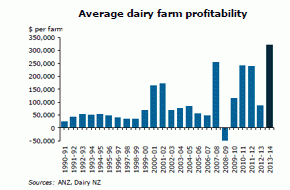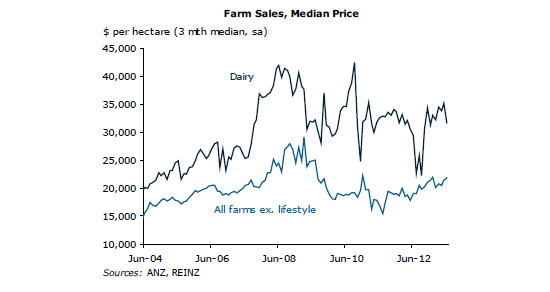
Content supplied by ANZ
The rural property market seems to have bucked the normal seasonal slowdown and drought effects.
Both turnover and average prices across the main farm types have remained unusually robust this winter.
High turnover was fuelled by strong sale volumes in the upper North Island regions, which were some of the worst affected by the 2012-13 drought. Elsewhere, turnover was flat to slightly lower in the bottom of both the North and South Islands.
Improved prospects for farm incomes (especially dairy), historically low interest rates, a competitive lending environment, and strong competition for a limited number of properties are expected to result in continued buoyancy this spring. Whilst welcome, some emerging evidence of pre-2008 financial crisis behaviours is not.
The absence of the normal seasonal slowdown in recent months, and the confidence brought by a higher dairy payout forecast, suggest activity levels for dairy-aligned pastoral properties could be very buoyant this coming spring.
Anecdotal evidence continues to point toward a shortage of properties to meet demand, with farms for sale attracting strong interest and multiple offers as competition rises.
However, the reported lack of listings could hold the spring market back, and we could struggle to see monthly turnover move above 80-90 percent of the 10-year average.
If a continued shortage persists then higher prices will be needed to attract additional properties to the market.
Add in low interest rates, investor fund interest, and a competitive lending environment, and things could really start to heat up as summer arrives.
Moreover, in some of the recent activity that has taken place we have started to see evidence of pre-financial crisis behaviours (chasing capital gain etc) emerge.
Such dynamics may ultimately draw the ire of the RBNZ who have warned about debt levels in previous financial stability reviews. Therefore, they will be closely watching developments as the dairy payout hits wallets.



-------------------------------------------------------------------------------------------------------------------------------------------
Farms For Sale: the most up-to-date and comprehensive listing of working farms in New Zealand, here »
-------------------------------------------------------------------------------------------------------------------------------------------
All the talk is how the high dairy payout forecast will drive activity in the rural property market this spring.
The market is notorious for activity and pricing following a one-year ahead outlook for incomes. The current forecast milk price of $7.50 plus extras certainly makes budgets for 2013-14 look very rosy.

While the last financial year won’t be remembered as stellar, the new season could well be – if Mother Nature is kind and farmers maintain disciplined expenditure.
The chart above shows that if milk volumes lift back to trend, and farm expenditure is held at levels close to 2012-13, then the average profit before tax for a dairy farmer could be a record $393,300, or $2,790 per hectare.
While expenditure is likely to lift and interest bills will be higher – taking some of the cream off the top – they would have to lift substantially for it not to be a new record for take-home farm incomes.
How much might find its way back into the rural property market and general economy is still debatable though.
Drought-affected farmers need a good year to rebuild cash reserves and resilience into their business (i.e. replenish feed stocks).
The latest Dairy NZ survey data for 2011-12 shows an average dairy farm now has a loan-to-value ratio (LVR) sitting around the 45 percent mark. This, combined with rising interest rates in 2014, could start to see some accelerated debt repayment from those with LVRs toward the higher end of the spectrum.
Other uncertainties also remain, such as:
1. Increasing environmental compliance standards from the Sustainable Dairying Accord. These will no doubt see more capital expenditure in the areas where standards are being lifted.
2. Fonterra shares remain stubbornly expensive, which will reduce appetites to pay higher property prices. Since the introduction of TAF late last year nearly $2,000-2,500 per hectare of additional capital is required to become fully shared.
3. Farmers are also looking to build more resilience into their business (e.g. capital expenditure to mitigate against cost of production rises) to cope with the forecast continued ups and downs of international dairy prices.
Still-strong demand from investor funds (both foreign and domestic) and those with strong balance sheets, combined with historically low interest rates, a shortage of suitable properties, and competitive lending environment are likely to see modest upward price pressure emerge on any dairy aligned property.
Examining the backward-looking indicators for the rural property market in the table above shows the turnover of dairy properties was solid in May and June. In the month of May, 19 dairy farms were sold, at an average sale value of $34,930/ha, or $35 per kg MS. The average farm size was 95 hectares and the average production/ha was 995 kgs of MS. In the month of June, 17 dairy farms were sold with an average sale price of $19,630/ha, or $27 per kg MS. The average farm size was 170 hectares and the average production/ha was 729 kgs of MS.
Finishing land prices have continued to oscillate around the $20,000/ha mark over the last two months. This supports our observation that prices have settled into a range of $18,000- $20,000/ha, with volatility outside this range driven by the monthly mix of sales. Activity levels were the strongest in the lower half of the South Island and Waikato. The number of sales of both grazing and arable land also picked up over the same period.
Average arable prices held above the $30,000/ha mark extending a trend evident since early 2013. However, on closer inspection the average sale price in the Waikato in recent months has been extremely high, perhaps artificially lifting this trend. Grazing land prices improved from their lows earlier in the year.
In the horticultural scene interest in green kiwifruit orchards has continued to pick up, with confidence improving as Psa has been less prevalent. Prior to the end of last year there were limited sales, and those who did sell averaged $90-$110k/canopy ha. In recent months there has been a larger number of green orchard sales ranging from $130-$160k/ canopy ha.
The viticulture land market has also been fairly strong with a number of sales at $180-$200k/ha in prime areas. This was driven by wineries looking to expand their production base. However, the large vintage this season has seen the market take a recent breathier as potential buyers wait to assess whether export demand is robust enough to ensure no excessive surplus emerges.
-------------------------------------------------------------------------------------------------------------------------------------------
Farms For Sale: the most up-to-date and comprehensive listing of working farms in New Zealand, here »
-------------------------------------------------------------------------------------------------------------------------------------------
1 Comments
All the numbers and graphics look very neat, but they all seem as averages and or seasonally adjusted so mean less than they seem and some refer to 2011/12..
But:
High turnover was fuelled by strong sale volumes in the upper North Island regions, which were some of the worst affected by the 2012-13 drought. Elsewhere, turnover was flat to slightly lower in the bottom of both the North and South Islands.
So people lost land/forced to move on due to the drought, otherwise (in the high production with water areas) Not much happened....
And, Interesting to think through their uncertainties.
and the need to add pipework (an classic example of an unexpected OMG)..
We welcome your comments below. If you are not already registered, please register to comment.
Remember we welcome robust, respectful and insightful debate. We don't welcome abusive or defamatory comments and will de-register those repeatedly making such comments. Our current comment policy is here.